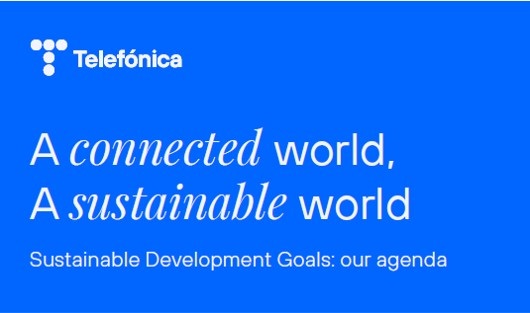- The company has integrated the goals of the United Nations Sustainable Development Goals into its strategy and measured its impact on them.
- As a global telecommunications operator, Telefónica focuses its fundamental action on SDG 9 by deploying sustainable, resilient and quality infrastructures and services.
Madrid, 7 July 2021. Telefónica presents the report ‘A sustainable world, a connected world’, an analysis of the direct and indirect impacts of the company’s activity on the goals of the United Nations Sustainable Development Goals after having integrated them into its strategy and defined objectives for each of them.
The company, as a global telecommunications operator, focuses its actions on Goal 9, “Industry, innovation, infrastructures”, deploying sustainable, resilient and quality infrastructures and services that are one of the main socioeconomic drivers of the regions in which Telefónica operates. Telefónica has therefore set itself the goal of providing faster and better quality Internet to people and businesses by making annual investments of more than 5,000 million euros for the deployment and improvement of communication networks, being responsible for the arrival of broadband (fibre, LTE, 5G) to many territories, including remote or hard-to-reach areas, as well as promoting innovation and entrepreneurship by supporting companies and startups to create new digital solutions and services.
“The SDGs are not isolated goals, but are interlinked between their corresponding targets, forming a system or network. There is therefore the possibility of achieving a direct impact on some SDGs and an indirect impact on others at the same time,” says Elena Valderrábano, Global Head of Sustainability at Telefónica. “This interconnection allows us to design our contribution strategy with greater precision and adapt it over time, defining the actions to be carried out or the products or services that fulfil our purpose of maximising our contribution to the socio-economic development of the regions”, Valderrábano points out.
The report shows the indicators that revolve around three pillars: Helping society to prosper, favouring socio-economic progress through digitalisation; Going beyond responsibility by generating trust; and Building a digital and greener future.
Technology for people
For Telefónica, therefore, it is not only about deploying technology, but also about putting it at the service of people. Making its solutions accessible is a priority purpose in the proposal to work on digital inclusion. Therefore, other goals such as SDG 4 (Education), 5 (Equality), 8 (Economic growth), 11 (Sustainable communities), 13 (Climate action) and 16 (Peace, justice and strong institutions) are unavoidable for the operator as they contribute to reducing the digital divide in all social and educational areas, putting technology and communications at the service of environmental protection as well as being a driver of economic growth for industrial and technological development. For example, for SDG 4, the goal is to promote digital skills development programmes through Fundación Telefónica’s educational projects such as Conecta Empleo, enlightED and ProFuturo, among others, and to empower its internal talent with training in new digital skills.
For SDG 8, Telefónica ensures that small and medium-sized companies have digital services, and that their purchasing processes incorporate ethical, social and environmental criteria. To this end, it promotes digitalisation for a more sustainable society and economy by supporting key sectors, encouraging investment in companies, collaborating with national and international organisations, etc.
Climate change is a central issue in the 2030 Agenda due to its capacity to compromise the achievement of all the Sustainable Development Goals. Telefónica identifies with the third pillar “Building a greener future”, assuming the magnitude of the challenge and acting ambitiously in this area, focusing on four of the environmental SDGs in the Agenda: 11, 13, 12 and 7, focusing on achieving greater energy efficiency, progressively increasing the consumption of renewable energies, reducing the carbon footprint and that of its supply chain and promoting the digitalisation of other sectors, thus favouring a reduction in their emissions.
This approach also allows us to take advantage of the opportunities of decarbonisation, be more competitive and offer our customers low-emission connectivity, decoupling business growth and the incorporation of new technologies such as 5G or fibre deployment from the increase in greenhouse gas emissions. We do this through efficiency and innovation, seeking all improvements and solutions that can reduce our impact and that of our partners and customers. The company’s Energy and Climate Change objectives include being net zero and are aligned with the 1.5ºC scenario of the Paris Agreement and validated by the Science Based Targets initiative (SBTi), as well as having a Sustainable Financing Framework in place since 2018.
Full Report “A connected world, a sustainable world”
